David Eisenman: Thought Leader Series
February 17, 2014
Spring 2021 update | FAQ page | Class flexibility for students | Novel coronavirus updates
February 17, 2014
February 17, 2014
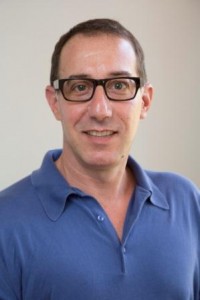 A Thought Leader Series Piece
A Thought Leader Series PieceBy David Eisenman
Note: February 20, 2014, is the United Nations’ World Day of Social Justice. The goal of the observance is to remove barriers people face due to gender, age, race, ethnicity, religion, culture, or disability. Dr. David Eisenman’s expertise is in public health and disasters.
In their book, “Resilience – Why Things Bounce Back,” authors Andrew Zolli and Ann Marie Healy argue that it’s time for sustainability to move over and make room for resilience.
Suddenly it seems to me that the whole world is talking about sustainability and resilience. In the field of disasters – my field – both are important concepts, complementary to each other and worthy of action and resources.
But frequently missing from the discussion is one of the most important determinants of sustainability and resilience – social justice. Social justice is central to both.
February 17, 2014
 Sustainability scientist Jianguo Wu delivered a keynote presentation at a Socio-Environmental Synthesis Research Proposal Writing Workshop, hosted in Annapolis, Md., by the National Socio-Environmental Synthesis Center in January.
Sustainability scientist Jianguo Wu delivered a keynote presentation at a Socio-Environmental Synthesis Research Proposal Writing Workshop, hosted in Annapolis, Md., by the National Socio-Environmental Synthesis Center in January.
The themes of the event, “Cities in Sustainable Resource Management” and “Surprise in Human Adaptation to Environmental Change,” were selected as examples of dynamic, complex socio-environmental problems that require the collaboration of disparate fields—from urban planning to oceanography and data science to human psychology—to begin to solve.
Dr. Wu is a Dean's Distinguished Professor of Sustainability Science, and his research areas include landscape ecology, urban ecology, biodiversity and ecosystem functioning, and sustainability science.
February 17, 2014
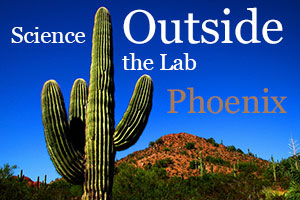 ASU's Consortium for Science, Policy, and Outcomes has added a new location for its popular Science Outside the Lab program that began in Washington DC more than a decade ago. The event will be held Monday, May 19 through Friday, May 23, 2014. Applications are due by March 15.
ASU's Consortium for Science, Policy, and Outcomes has added a new location for its popular Science Outside the Lab program that began in Washington DC more than a decade ago. The event will be held Monday, May 19 through Friday, May 23, 2014. Applications are due by March 15.
The program introduces students to the relationships among science, technology and innovation policies, and the societal outcomes in places where important decisions are made. During the new one-week workshop—now offered in Phoenix—students meet and interact with decision makers who fund, regulate, and shape innovation and critique, publicize and study science, including patent attorneys, insurers, venture capitalists, city and state officials, lobbyists, consultants, regulators, journalists, and others.
Science Outside the Lab
The long-running Washington, DC science policy immersion program returns for the Summer of 2014. Graduate students in science and engineering who are interested in how decisions about science and innovation funding, regulation and policy are made will benefit from this program. Students with an interest in careers in science policy will also find this to be an excellent opportunity to learn about important fellowships and meet current science and innovation policy professionals.
February 17, 2014
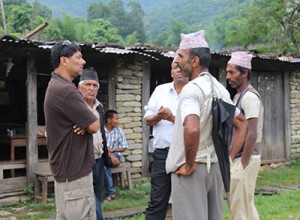 Sustainability scientist Netra Chhetri leads an interdisciplinary team of scholars and practitioners working on a project in western Nepal to help farmers adapt effectively to climatic change. The team includes representatives from ASU, University of Hawaii, Local Initiatives for Biodiversity Research and Development (a Nepali NGO), Regional Directorates of the Department of Livestock Services, Western Region, and the Regional Agriculture Research Station, Lumle (agricultural and livestock research and extension agencies of the Government of Nepal), and Agriculture and Forest University (a Nepali university).
Sustainability scientist Netra Chhetri leads an interdisciplinary team of scholars and practitioners working on a project in western Nepal to help farmers adapt effectively to climatic change. The team includes representatives from ASU, University of Hawaii, Local Initiatives for Biodiversity Research and Development (a Nepali NGO), Regional Directorates of the Department of Livestock Services, Western Region, and the Regional Agriculture Research Station, Lumle (agricultural and livestock research and extension agencies of the Government of Nepal), and Agriculture and Forest University (a Nepali university).
Chhetri’s three-year project, Adaptive Pathways to Climate Change (APaCC): Livestock and Livelihood Systems in Gandaki River Basin, examines the adaptive capacity of farmers and livestock keepers vulnerable to climate and other livelihood stressors, and links this understanding to locally relevant climate adaptation methods in the Gandaki River Basin. His research advances understanding of how a society’s adaptive capacity to climate variability and change is shaped by the geographical region’s social, political, institutional and biophysical contexts. He commented, “We believe that carefully generated and user-driven knowledge enhances the capacity of farmers to adapt to the threat posed by climate and other ongoing changes.”
View Source | February 17, 2014
 The Arizona Solar Summit brings together people and organizations to advance the solar industry on both the regional and national levels, creating a network to propel Arizona to national prominence in the industry.
The Arizona Solar Summit brings together people and organizations to advance the solar industry on both the regional and national levels, creating a network to propel Arizona to national prominence in the industry.
The fourth annual Arizona Solar Summit, part of the 2014 Sustainability Solutions Festival, will focus on introducing innovative policies, programs and technologies that are critical to reshaping Arizona’s energy markets.
View Source | February 17, 2014
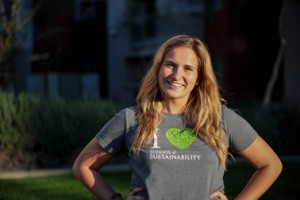 Ask Isabelle Lishewski what her favorite part of being a student at Arizona State University is and pat comes the reply, “Telling my Sun Devil story to a group of high school students and their families while walking backwards during a campus tour.”
Ask Isabelle Lishewski what her favorite part of being a student at Arizona State University is and pat comes the reply, “Telling my Sun Devil story to a group of high school students and their families while walking backwards during a campus tour.”
The Toledo, Ohio native considers her Sun Devil story nothing short of a serendipitous journey thus far.
As a student worker at the Walton Sustainability Solutions Initiatives, Lishewski has been a participant, as well as witness to the hard work that has gone into organizing the first-ever Sustainability Solutions Festival. The event is one of WSSI’s eight programs designed to support sustainability research, develop solutions, build a global sustainability network, and groom the next generation of sustainability leaders.
View Source | February 17, 2014
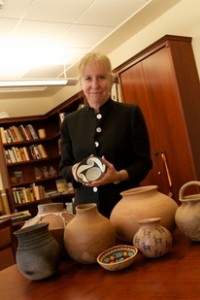 What role does pre-existing vulnerability play for people who experience a climate shock? Does it amplify the effect of the climate shock, or is the effect negligible?
What role does pre-existing vulnerability play for people who experience a climate shock? Does it amplify the effect of the climate shock, or is the effect negligible?
Four Arizona State University archaeologists are looking into this as part of an international team examining how people can be most resilient to climate change when it comes to food security.
View Source | February 13, 2014
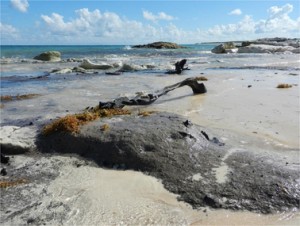
Assembling a picture of past environments always involves detective work. The reward is a clearer understanding of how natural and human forces have changed environments in the past, giving insights to how modern-day environmental changes take place.
Working with especially elusive evidence, Janet Franklin, ASU professor of geography, is participating in an effort to understand the profound changes in plant and animal life that occurred on the oceanic islands of the West Indies since the end of the last ice age.
View Source | February 12, 2014
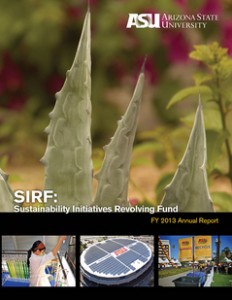
The recently released 2013 Sustainability Initiatives Revolving Fund (SIRF) annual report chronicles $5.6 million in investments that support Arizona State University.
The investments included seven energy conservation projects and six student and campus-oriented projects at ASU. From lighting retrofits, to specialized recycling bins, to an urban garden at the Downtown Phoenix campus, SIRF funds thrive in some surprising places.
In addition to project details and descriptions of all SIRF projects financed in 2013, the report includes three Q-and-A interviews with ASU SIRF fund recipients who have put their sustainability ideas into action.
View Source | February 11, 2014
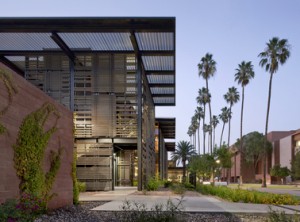
The Health Services Building on Arizona State University's Tempe campus has earned a LEED platinum certification from the U.S. Green Building Council.
Health Services is the second ASU building to receive a platinum certification, which is the highest USGBC green building ranking under its LEED (Leadership in Excellence in Environmental Design) program. The Health Services Building is also the 38th ASU building to be LEED certified.
The Health Services Building underwent a major renovation and expansion that was completed in March 2012 by ASU's Facilities Development and Management unit.
View Source | February 10, 2014
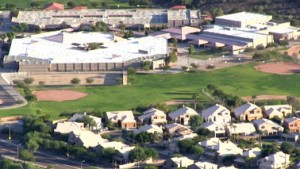 Life in a warming world is going to require human ingenuity to adapt to the new realities of Earth. Greenhouse-gas-induced warming and megapolitan expansion are both significant drivers of our warming planet. Researchers are now assessing adaptation technologies that could help us acclimate to these changing realities.
Life in a warming world is going to require human ingenuity to adapt to the new realities of Earth. Greenhouse-gas-induced warming and megapolitan expansion are both significant drivers of our warming planet. Researchers are now assessing adaptation technologies that could help us acclimate to these changing realities.
But how well these adaptation technologies – such as cool roofs, green roofs and hybrids of the two – perform year-round, and how this performance varies with place remain uncertain.
View Source | February 10, 2014
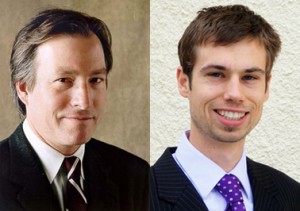 Arizona State University engineers will lead two multi-university/industry research teams in support of a new U.S. Department of Energy program to develop technologies that use the full spectrum of sunlight to produce inexpensive power during both day and night.
Arizona State University engineers will lead two multi-university/industry research teams in support of a new U.S. Department of Energy program to develop technologies that use the full spectrum of sunlight to produce inexpensive power during both day and night.
The department's Advanced Research Projects Agency – Energy (ARPA-E) recently announced allocation of $30 million in funding for 12 projects selected to conduct research for its Full-Spectrum Optimized Conversion and Utilization of Sunlight (FOCUS) program.
February 6, 2014
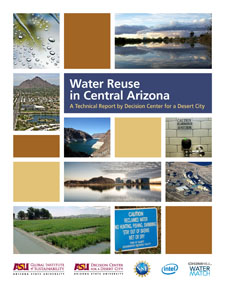 In an attempt to inform policy conversations around wastewater use in Arizona, Arizona State University’s Decision Center for a Desert City (DCDC) this week released a new technical report. The report, Water Reuse in Central Arizona was authored by Ariane Middel, Ray Quay, and Dave White and explores issues critical to water reuse, along with challenges and opportunities for the future.
In an attempt to inform policy conversations around wastewater use in Arizona, Arizona State University’s Decision Center for a Desert City (DCDC) this week released a new technical report. The report, Water Reuse in Central Arizona was authored by Ariane Middel, Ray Quay, and Dave White and explores issues critical to water reuse, along with challenges and opportunities for the future.
Covering topics including existing and projected wastewater supply and demand, potential for increased competition and costs, the role of public perceptions, and industrial perspectives, the report highlights issues vital to the water sustainability of Arizona and presents a framework to address public policy issues.
View Source | February 6, 2014
ASU community invited to learn current sustainability business trends
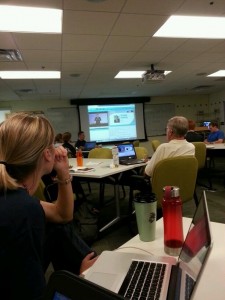 For the first time, the annual GreenBiz Forum, a hallmark conference hosted by GreenBiz Group, is coming to Arizona State University as a shadow conference for students, faculty and staff, called GreenBiz U. Presentations at GreenBiz Forum, set to take place Feb. 18-20 in Scottsdale, will be simulcast for free on ASU’s Tempe campus during GreenBiz U.
For the first time, the annual GreenBiz Forum, a hallmark conference hosted by GreenBiz Group, is coming to Arizona State University as a shadow conference for students, faculty and staff, called GreenBiz U. Presentations at GreenBiz Forum, set to take place Feb. 18-20 in Scottsdale, will be simulcast for free on ASU’s Tempe campus during GreenBiz U.
GreenBiz Forum, which happens twice a year in various locations around the country, provides an in-depth look at today’s sustainable business challenges and opportunities.
"GreenBiz Forum brings together sustainability leaders from the world’s biggest corporations to discuss key trends and best practices,” says Joel Makower, chairman and executive editor of GreenBiz Group. “We’re excited to bring this wealth of insight and inspiration to the larger ASU community, which includes tomorrow’s business leaders.”
View Source | February 6, 2014
New position created to encourage, facilitate cycling on and off campus
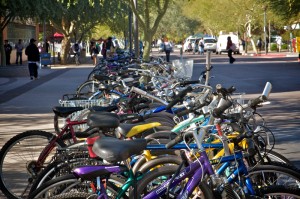
Arizona State University Parking and Transit Services announces Donna Lewandowski has been hired to serve as Bicycle Program Manager. Lewandowski, who is the first to work in this newly created post, begins her job duties on Monday, Feb. 3, 2014.
Lewandowski’s primary responsibilities will be to develop, implement and maintain programs and activities that encourage bicycle usage on and off campus. She will be the lead liaison in connecting bike commuters with services that can help them maintain their bikes and stay safe on the roads. Lewandowski will also assist cyclists with incorporating other modes of transportation that contribute to ASU sustainability goals into their daily commutes.
Lewandowski comes to ASU from Tucson Medical Center, where she served as a community outreach specialist since last March. She coordinated Safe Kids Pima County, a diverse community coalition for childhood injury prevention. Her duties included planning and executing community safety events aimed at children’s and women’s health, as well as developing grant application, fundraising and marketing materials for the Safe Kids coalition.
February 5, 2014
In an attempt to inform policy conversations around wastewater use in Arizona, Arizona State University’s Decision Center for a Desert City (DCDC) this week released a new technical report. The report, Water Reuse in Central Arizona was authored by Ariane Middel, Ray Quay, and Dave White and explores issues critical to water reuse, along with challenges and opportunities for the future.
 Covering topics including existing and projected wastewater supply and demand, potential for increased competition and costs, the role of public perceptions, and industrial perspectives, the report highlights issues vital to the water sustainability of Arizona and presents a framework to address public policy issues.
Covering topics including existing and projected wastewater supply and demand, potential for increased competition and costs, the role of public perceptions, and industrial perspectives, the report highlights issues vital to the water sustainability of Arizona and presents a framework to address public policy issues.
"Several recent reports and commissions have pointed to increased water reuse as an important strategy to address projected water supply deficits resulting from droughts and anticipated climate change impacts" said Dave White, a co-author of the report and Co-Director of the Decision Center for a Desert City at ASU.
"While we share this common goal, this report demonstrates, however, that effluent reuse is certainly not a silver bullet to water sustainability. Many issues remain that must be addressed as we move forward. There are technical, economic, environmental, cultural, legal, and political dimensions."
The publication is the result of collaboration between Arizona State University, Intel Corporation, and CH2M Hill’s WaterMatch.
"Sustainable water management is a key focus at Intel," said Gary Niekerk, director of Corporate Citizenship at Intel. "We created the collaboration with CH2M HILL‘s WaterMatch, ASU’s Global Institute of Sustainability and ASU’s Decision Center for a Desert City to increase awareness of water sustainability issues in our local community."
Once thought of as just a waste product, communities across the United States are increasingly considering wastewater a valuable resource. In these communities, the effluent from wastewater treatment plants can relieve the stress on overstretched water supplies by replacing other sources for non-potable, or sometimes even potable, uses.
Effluent is currently used in Arizona for urban and agricultural irrigation, industrial purposes, and for recharging groundwater aquifers. According to the new report, effluent reuse in the Phoenix Active Management Area may be as high as 82 percent.
A majority of effluent is used to cool Arizona Public Service’s Palo Verde Nuclear Generating Station. Some of these processes use effluent that has been treated for higher quality, resulting in reclaimed water. Reclaimed water is used to water parks and golf courses, as well as non-edible agricultural irrigation (i.e. for cotton).
This report highlights the current use of effluent as a key water conservation strategy for Arizona’s Sun Corridor—the combined metropolitan areas of Phoenix and Tucson. Though beneficial for helping curb the demand for water in Central Phoenix, effluent offers many challenges for future water managers and decision makers.
A key challenge for producers of effluent will be cost. Wastewater treatment is currently the largest consumer of energy in Central Phoenix. In the future, this process will become even more expensive as wastewater treatment becomes more sophisticated to remove the brine (salt) and pharmaceuticals from water. A key challenge for effluent consumers will be competition.
Ray Quay suggests that, "Here in central Arizona, as in southern California and northern Florida, most effluent is already being reused. As the price of water supply goes up, so will the value of effluent. In an open market this may put it economically out of reach of current effluent users, who may find ground water cheaper to use."
Thus the key to keeping water management sustainable is to continue to keep effluent cost-effective in comparison to the cost of pumping groundwater.
In addition to the authors, contributors to the report include Rob Melnick, Executive Dean and John Sabo, Director of Research, each from the ASU Global Institute of Sustainability, along with DCDC staff Sally Wittlinger and Liz Marquez and student interns Rud Moe and Saad Ahmed.
The review is based in part on a series of interviews and expert reviews by representatives from public, private, and nonprofit agencies.
View Source | February 4, 2014
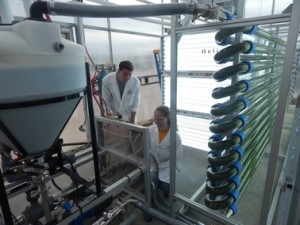
A newly announced partnership between Arizona State University, Heliae and SCHOTT North America is a big step forward on the path to accelerate algae technology.
The collaboration will bring Heliae’s algae production technology to ASU’s algae testbed facility. Through the partnership, SCHOTT financed a Helix photobioreactor built by Heliae and installed at ASU’s Department of Energy-funded algae testbed facility on the Polytechnic campus. Over the next several years, algae researchers at ASU will leverage the Helix photobioreactor to propel the understanding of algae production technology, including an investigation into the effect of glass tubing innovations on the yields and economics of algae production. The reactor will also deliver the production of high-quality algae cultures, which will support broader ASU algae operations.
View Source | February 4, 2014
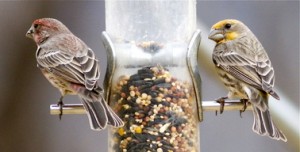 Humans living in densely populated urban areas have a profound impact not only on their physical environment, but also on the health and fitness of native wildlife. For the first time, scientists have found a direct link between the degree of urbanization and the prevalence and severity of two distinct parasites in wild house finches.
Humans living in densely populated urban areas have a profound impact not only on their physical environment, but also on the health and fitness of native wildlife. For the first time, scientists have found a direct link between the degree of urbanization and the prevalence and severity of two distinct parasites in wild house finches.
The findings are published in the Feb. 4 issue of the journal PLOS ONE.
A team of researchers from Arizona State University made the discovery while investigating intestinal parasites (Isospora sp.) and the canarypox virus (Avipoxvirus) found in house finches. The group also studied the effects of urbanization on the stress response system of the finches.
View Source | January 31, 2014
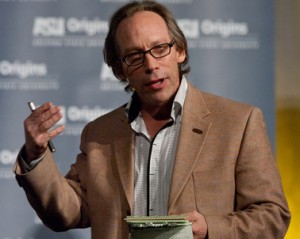 Lawrence Krauss, an Arizona State University Foundation Professor in the School of Space and Earth Exploration and the Department of Physics, has been elected to the International Academy of Humanists.
Lawrence Krauss, an Arizona State University Foundation Professor in the School of Space and Earth Exploration and the Department of Physics, has been elected to the International Academy of Humanists.
The academy, which includes Nobel laureates James Watson and Steven Weinberg, sociobiologist Edward O. Wilson and author Salman Rushdie as members, is limited to 80 persons. It was established in 1983 to recognize distinguished humanists and to disseminate humanistic ideals and beliefs. Once elected, laureates are members for life.
Members of the academy are committed to free inquiry in all fields of human endeavor, a scientific outlook and the use of the scientific method in acquiring knowledge and promotion of humanist ethical values and principles.